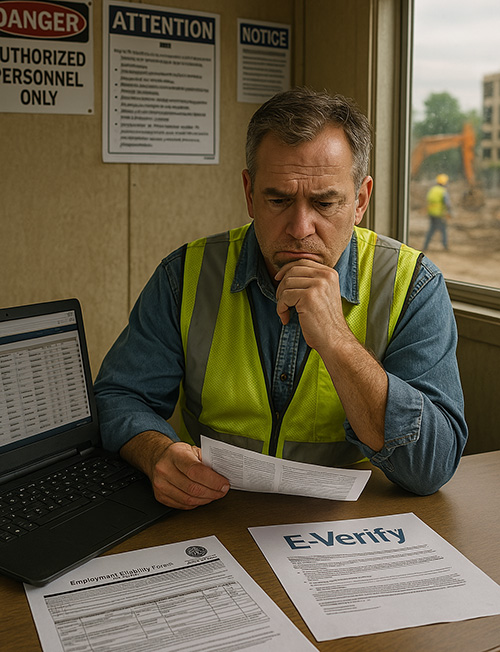#5 of 5 in our series, “The New ICE Age”
About This Series
The new administration has committed to higher tariffs and ever greater enforcement of legal employment laws. Because of its dependence on materials and immigrant labor, construction is particularly at risk. In this series, Safe Site Check In will summarize the risks and how construction project owners and contractors can prepare themselves for “The New ICE AGE”. We’ll also suggest how Safe Site Check In can helps mitigate enforcement risks from project owners down to workers.
Who’s on the Jobsite: Workers, Subcontractors, Visitors, and Project Stakeholders
A wide variety of people come onto jobsites: Project Owners, Architects and Designers, Engineers, Managers, Trade workers, Subcontractors, Visitors, Regulators and Vendors. And GCs are responsible for jobsite security, safety and compliance for them all.
Why a Legal Workforce Matters in Construction
GCs have a critical role in keeping them all safe and maintaining a legal and ethical workforce. That responsibility extends beyond their own direct employees.
GCs must also take steps to verify the employment eligibility of individuals hired by their subcontractors. At the same time, they must also avoid discrimination against protected groups. Failure to do so can expose GCs to significant legal risks, financial penalties, and project disruptions.
Finally, our legal resident immigrant workers are justifiably concerned about ICE disrupting their desire to work in the United States. GCs have both an economic and moral obligation to protect their right to work.
Risks General Contractors Face Without Workforce Verification
Legal and Financial Penalties
Failing to verify employment eligibility can result in fines and lawsuits, especially if undocumented workers are found on site. GCs may also face ICE investigations or Department of Labor scrutiny.
Reputational and Ethical Risks
Publicized enforcement actions or allegations of worker exploitation can damage a GC’s reputation and strain relationships with project owners or the local community.
Disruption to Project Schedules
If ICE detains workers or stops work due to non-compliance, projects may face costly delays, missed deadlines, and contract disputes.
By adopting Safe Site Check In badges that include both worker photos and data confirming legal employment, GC’s can feel more confident the risks are managed efficiently. Field managers and workers can quickly get to building without cumbersome paper processes.

How Safe Site Check In Supports Legal Workforce Management
1. Digital Photo Badges with Worker Identity Data
Jobsite security is critical no matter what and all begins with establishing the identity of all persons permitted to be onsite. HR resources should verify personal identification before hiring and badging employees, and field teams should do the same if onboarding in the field.
We recommend you use Safe Site Check In to create digital jobsite photo badges when you onboard a new worker. Not just ICE agents, but your project owner and entire field team can visually confirm that the wearer of a badge is actually the badge owner. Photo badges are especially important if ICE visits your jobsite. Visual photo badges show your confidence in your jobsite controls, speeds up the verification process and gets everyone back to work faster.
2. E-Verify Data Fields in Worker Profiles
If the GC is the prime, and the project is a federal contract subject to the Federal Acquisition Regulation (FAR) E-Verify clause, you must ensure that subcontractors at all tiers with subcontracts over $3,000 also enroll in and utilize E-Verify.
While HR typically verifies personal identification before hiring, GC’s should strongly consider having the HR department use E-Verify as part of the hiring process for all its employees.
Why? E-Verify supporting documentation should be securely stored at HQ and not copied unnecessarily for privacy reasons. E-Verify data is portable while its documents are not. So you can capture key data fields for use in the field in case ICE visits there, or at HQ for reporting back to project owners.
We recommend you capture these data fields and put them in worker profile data when onboarding workers to your project:
- E-Verify Case #
- E-Verify Case Status (or Description)
- Employer (or Subcontractor) Name
- First Name
- Last Name
- Date of Birth
- Hire Date
3. Subcontractor Onboarding and Compliance Tracking
Request this data from subcontractors for all workers onboarded to your jobsite using Safe Site Check In. Subcontractors can onboard their own workers into a Safe Site Check In jobsite, thereby demonstrating their compliance with employment eligibility verification laws but without having to copy and transport those highly private documents.
If there are any doubts, consider conducting on-site reviews of subcontractor employment records, but only with proper notice and in accordance with legal guidelines.
Working with Legal Counsel to Ensure Compliance
Of course, consult with an immigration attorney to ensure compliance with all applicable laws and regulations, especially when dealing with complex situations or potential red flags.
Legal counsel can help you:
- Review subcontractor hiring practices
- Address specific E-Verify or I-9 issues
- Respond appropriately if ICE visits your jobsite
Summary: Safe Site Check In Makes Legal Workforce Management Easier
Safe Site Check In uses digital data to protect all construction project stakeholders: project owners, GC, subcontractors, even workers.
Use our digital photo badges connected to worker profiles containing E-Verify data. Even if ICE visits, you’ll get all stakeholders building again fast.
Sign up for a demonstration and learn just how easy ensuring legal employment can be.
Watch our Digital Photo Badges Video
Sources and Resources
- USCIS E-Verify Website: https://www.e-verify.gov/
- Federal Acquisition Regulation (FAR): https://www.acquisition.gov/far/
- Florida Department of Economic Opportunity (DEO): https://floridajobs.org/
- USCIS Handbook for Employers: https://www.uscis.gov/i-9-central/form-i-9-resources/handbook-for-employers-m-274

David Brian Ward is a CEO and Founder of Safe Site Check In LLC, a digital jobsite management platform launched in 2020 for the Construction industry. With over 40 years of experience in the technology industry, having launched and grown several successful companies. Mr. Ward is a now a SaaS entrepreneur and innovation leader in the Construction industry.

